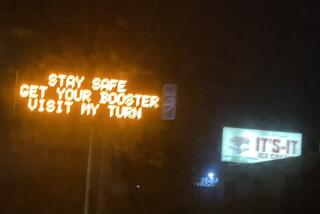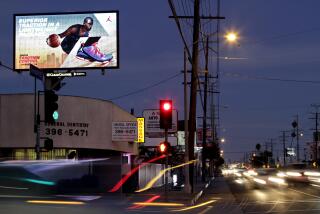Itâs a Wrong Way to Tipperary
DUBLIN, Ireland â It promises to be a roadside revolution in Ireland -- signs that actually tell you where youâre going.
For decades in the countryside, getting from A to B has required asking directions from locals. Visitors had to hope that nativesâ explanations proved less misleading than the road signs: cast-iron arrows with tiny black-and-white script, which worked best in the days when traffic was more bicycle than car.
The government, hoping to rescue tourists lost in the countryside in their rental cars, recently launched a $5.3-million project to erect easy-to-read, large signs for some of the more bewildering byways.
Pat Gallagher, junior environment minister, conceded that the project was long overdue. He said the first counties to be targeted -- Wexford, Kerry, Galway, Sligo and his native Donegal -- would get their new bearings by the end of the year and most of the other 21 counties by 2007.
âIf we want to market ourselves successfully, basics like signposting should be in place,â Gallagher said. âIt really has been a confusing experience for too many of our international guests.â
Indeed, getting lost amid Irelandâs lattice of narrow, hedge-lined byways has been a traditional part of the tourist experience.
Tales abound of following the 1920s-era signs to a particular promised land, only to find that the pointers disappear at a crucial crossroads -- or, even worse, to one that claims that the hunted village in question is now farther away than when you started.
Complicating matters, older signs offer distances in miles, newer ones in kilometers -- but you often canât be sure which is which. New speed-limit signs, meanwhile, are often presumed by visitors to be in kilometers, but theyâre still in miles.
But you generally have to drive slowly to get properly confused -- because signs are small and placed so that youâre often passing them before you can read them.
The old-fashioned signs are nonetheless beloved icons of Irelandâs emergence as an independent state in the 1920s, and the government has no plans to take them down.
Rust and theft are gradually doing the job, particularly in the last decade. With an explosion of Irish-themed pubs worldwide, organized gangs have stripped whole parishes of their signs for export to faraway bars. A particular favorite for theft is the sign to one County Kerry village that reads, âInch, 1 mile.â
Veterans of Irelandâs maddening road system arenât holding their breath for the day when they can navigate the countryside without recourse to a loquacious man on a tractor.
âNever mind the countryside; I still get lost in Dublin,â said Irish Times columnist Kevin Myers, a road-sign crusader who argues that the Irish have never understood the functional point of signs.
âYouâve got extraordinarily misleading signs and signs that tell outright lies, and most of these are new,â he said. âDublin Corporation is putting up signs at the moment that are designed to baffle anyone from outside Ireland.â
âThey refer to Dublin as âan Lar,â which is Gaelic for the city center -- and itâs a term that nobody uses because we all speak English here,â Myers said. âEverybody in Europe would understand the word âcenter,â so naturally we canât use that. The powers that be are intent on putting up signs in a dead language for pseudo-cultural purposes and doing nothing to help visitors.â
More to Read
Sign up for The Wild
Weâll help you find the best places to hike, bike and run, as well as the perfect silent spots for meditation and yoga.
You may occasionally receive promotional content from the Los Angeles Times.





